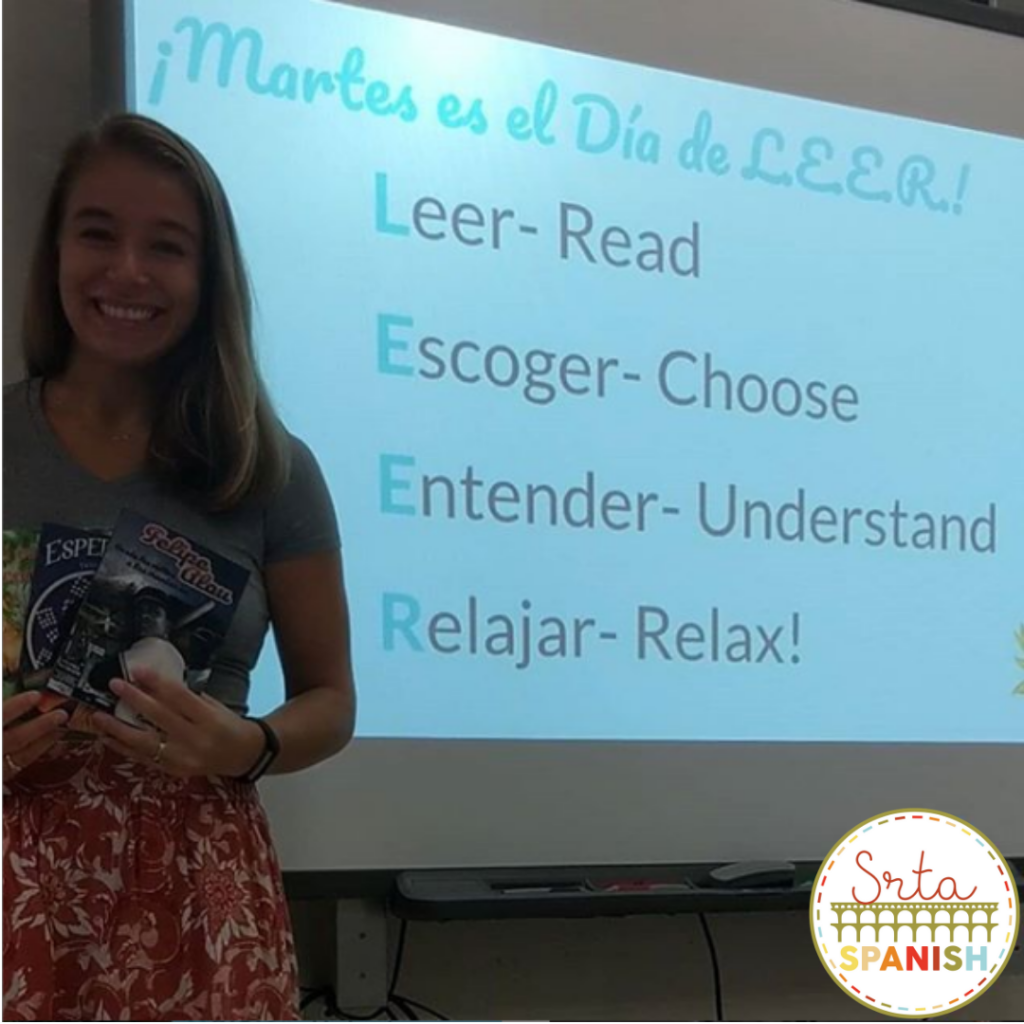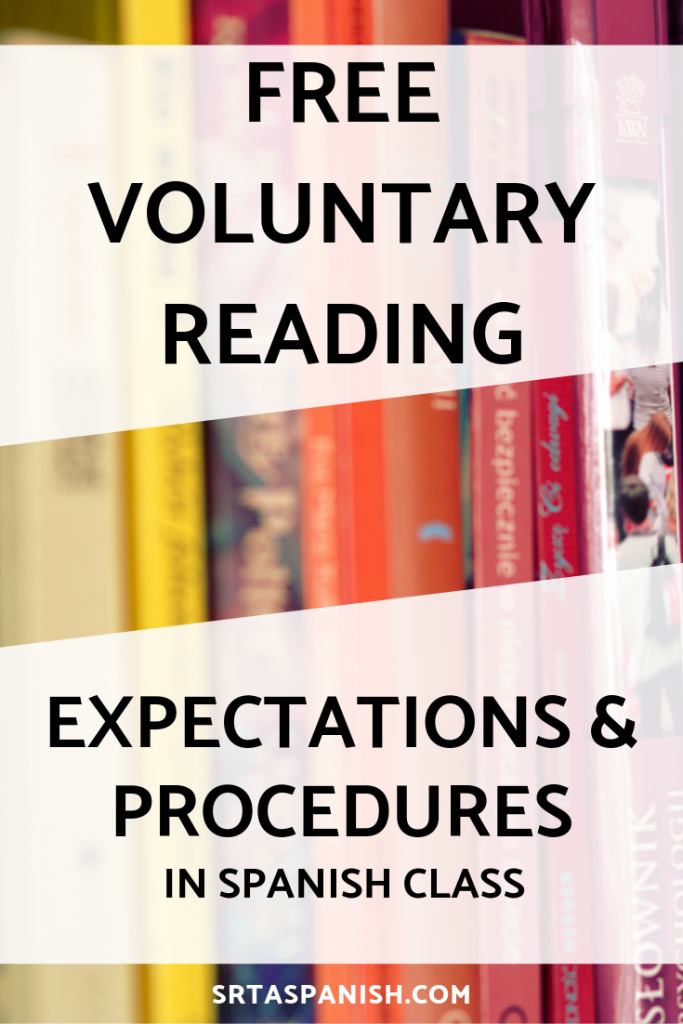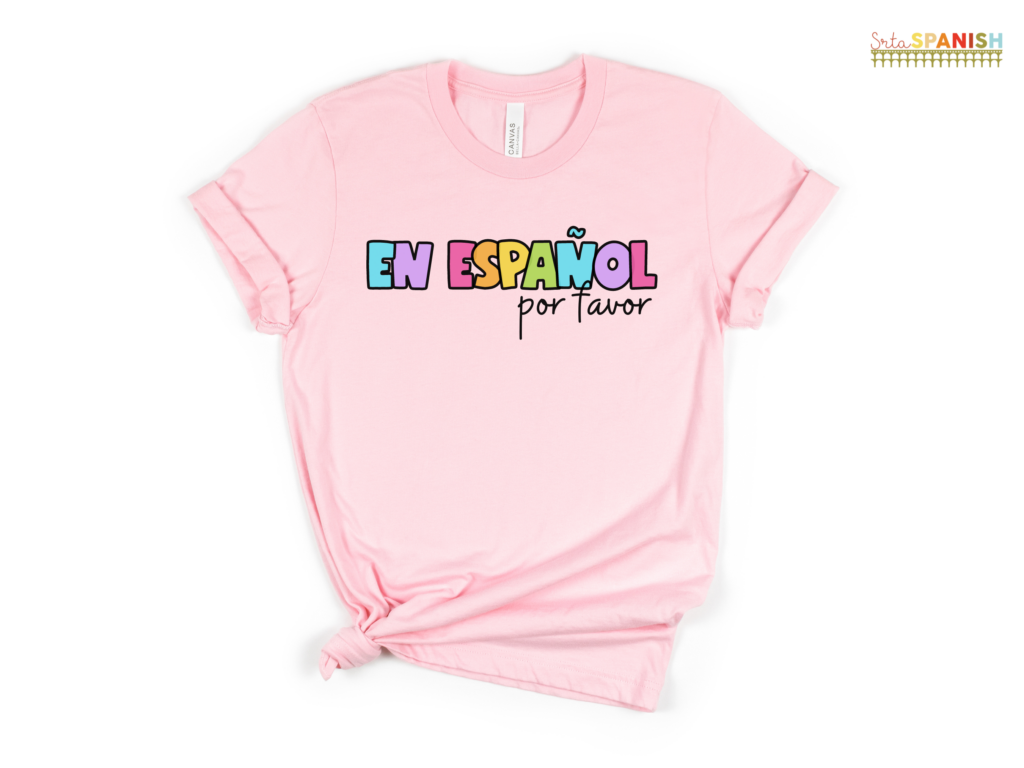Happy Tuesday everyone! Tuesdays in my Spanish I classroom this year are Free Voluntary Reading (FVR) days. This is a routine I have incorporated this year into my weekly plans, and I have been enjoying it so far.
I have already shared posts on how to find resources for your classroom library and a post on my own classroom library (wish)list, but I wanted to share some of the expectations I have set with my students during FVR and how things are going with it so far this year!
See more on readers in your classroom:
- Classroom Library List
- Where to find reading materials for Spanish class
- Books Your Novice Students Will Love
- Author Spotlight series – check out books from my favorite authors!
- Recommendations for Readers in Spanish Class Levels 1-AP
- How to Read a Novel with your Spanish Class
Watch the Video
Free Voluntary Reading Expectations
We start every Tuesday with a quick reminder of the expectations during FVR. The short and simple expectations go like this:
- Choose something to read.
- Read for 5 minutes.
Simple, right? Well…we have also been doing a LOT of discussion of both of those things.
1. Choose something to read.
How do you coach your students to choose something to read? You want them to choose the “right” material, but you also want to make sure it’s helpful for them! Here’s some of the language we have been using:
Pick something INTERESTING & COMPREHENSIBLE.
- You should enjoy it and it should be relatively easy for you to read.
- It does not have to be completely fascinating, and you do not have to understand every single word. It just has to hold your interest for a while, and it has to be something that you can mostly understand.
- If you find you don’t like it or it doesn’t make sense to you, choose something else to read next time.
- You can also read the same thing again if you want. That is a good option too!
None of that language came from me. Check out Bryce Hedstrom’s resources here!
We have also used reading resources that get sent home to my co-worker’s first-grade kids. It’s been really helpful and spot on, so if you have any elementary ed friends, give them a call!
2. Read for 5 minutes.
That seems simple, right? It is nice to spell out exactly what it means though, so here is what we have clarified:
While we are reading there are NO DISTRACTIONS:
- No getting new books
- No bathroom passes
- No throwing away trash
- No talking
- No writing
- No sleeping
- No drawing
We are reading. We are not avoiding reading, and we are not pretending to read.
Again, none of that language came from me. Here is Bryce Hedstrom’s poster that you could print off and point to if needed!
Free Voluntary Reading Procedures
Every Tuesday we start off by refreshing ourselves on those procedures and expectations. It is getting a little faster, but I really really want to have zero questions about what I’m looking for behavior-wise during this time.
After those reminders, I dismiss by groups of students to pick up reading material. I would like to eventually transition into just reading right away at the beginning of class every Tuesday, but we’ll get there! I dismiss using different chunks of language. “My birthday is in…”, “I am wearing..”, something like that. Once everyone has reading material I start the timer and read.
At first, I was projecting the timer for students, but I realized that I kept looking up and checking it. When I found myself doing it, I noticed that students were doing it too. AGH. We’re reading…not checking the time over and over for 5 minutes! Now I set an alarm on my phone and jump out of my seat when it goes off.
I also read with my students. In some classes, I sit at my desk and read. Sometimes I sit at a table group if there’s space. Sometimes I stand near a group that seems like they’re having a hard time settling, but I just stand there, read, and let proximity work.
Free Voluntary Reading Wrap-Up
This has been something that I have changed a few times as we’ve progressed through the weeks. First off, I simply asked students to hold up what they read if they would recommend it to someone else. We looked around to get an idea for something else to pick up.
I have also asked students to raise their hands if they plan on picking up the same material next week because it helps me get an idea for how many students have found something that they seem to enjoy, and who may need help finding something.
Now that we have kind of settled in, I ask students to tell their groups one thing that happened in their reading. I either join a group or float and listen to what they’re talking about. Finally, we pack up the books so it’s easy for me to carry them to my next classroom and transition into our next activity.
Free Voluntary Reading ..Name Change?
One more thing! I actually don’t call this Free Voluntary Reading or FVR in my classroom at all. Ever. My thought was because I was sure that I would have at least one student get on the “But it’s not voluntary!!” train and I just wanted to avoid that battle altogether.
We say martes es el día de L.E.E.R and L.E.E.R. stands for..

which I love! Kristi Kremer shared this in a Facebook group and I think it’s just perfect to stand for what we’re trying to do with this routine.
Sign up to print them off for your classroom! Don’t forget to tag me on Instagram if you hang them!
Free Voluntary Reading – What do you do?
I’d love to hear about what you are currently doing in your classroom! Do you have any of these same procedures also? Thanks for sharing your tips with me!

Click here to pin this post for later!
You may also like..
Check out these cute teacher tees to wear during your lesson!






Many of the things you quoted are from Bryce Hedstrom. https://www.brycehedstrom.com/free-stuff
AHHH YES. THANK YOU!! I’ll link it above too! I appreciate your help!
I just starting using the FVR procedures from Bryce this year and I’m in love! He got me hooked at the NTPRS conference. One thing I have started doing after is giving an opportunity for the kids to quickly share with a scaffolded option. I have written up on the board “Leí _____” and “Es”, along with a list of adjectives one of my classes came up with. From there, each student can comfortably give a commentary of their book and then those who are more confident go and add more to their reflection! So far it has been awesome!
Oh I LOVE that! That’s a great idea! Definitely adding it to my wrap up procedures. Thank you so much for sharing!
I love this! Which adjectives do you offer students? Also, do they respond to these prompts in a written or oral form?
It says the L.E.E.R. Acronym Posters are no longer available and it doesn’t say what that stands for. Can you tell me what it stands for and where to find those?
Thanks for reaching out! My blog recently went through an update so I was in the process of re-uploading all of those files and images. It should all be available now! Let me know if you have any other questions.
Asking the Ss to share what their book is about or what happened, is this in the TL?
Some days TL, and some days English! If I want them to respond in the TL I give them supports on the screen to help them out!
Hi there! I call this Leer libro. From the book they are reading in target language, timer is set at 15 min. They are to write name of book and author. They save this piece of paper/vocabulary for the test. While reading, they are to select 7 words they don’t know and translate and 2 words they already know…withoumt context clues or pics. At end of possibly 7 or 8 readings, students will have compiled a personal vocabulary list. During their verbal exam with me, they are to bring their paper and they are to have memorized their personal list of vocabulary words.
Again. Thank you so much. I am loving all your posts. I am slowly reading, digesting and taking notes and buying some 🙂 to implement next year. I am going to finally use the Qué tal? magazines. I kept getting one classroom sets, and I could not quite figure it out. I also have a lot of kids books. I need to get on more reading materials. Do you think I can put articles on the topics that we are covering as an option?
Again. Thanks.
The Qué tal magazines are a great resource! Kids books can be tricky, because they’re really designed for people who have been speaking the language for much longer than many of our students have been! Some are great, some are super challenging – just be discerning in them! Articles on things you’re learning about in class are a great option! You may also like this post:
https://srtaspanish.com/2018/09/08/5-ways-to-build-your-fvr-library-for-free/
Have you ever tried using electronic resources for books? Uniteforliteracy.com has easy books that can also be narrated so the kids can listen as they read!
I’ve used some online sites, but not many! Thanks for the recommendation!
When do beginner students start reading?
Thank you for your ideas.
Hi! I have waited until around the first quarter in the past 🙂
How do I begin this Level 1 novices? Do I offer something with lots of pictures and cognates?
I like to wait til at least the first quarter, then yes! Pictures, cognates, and making “books” out of stories we’ve done in class are the things that have been the best for my “newbies”.